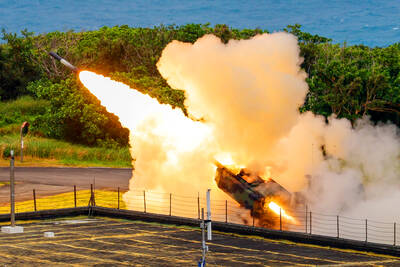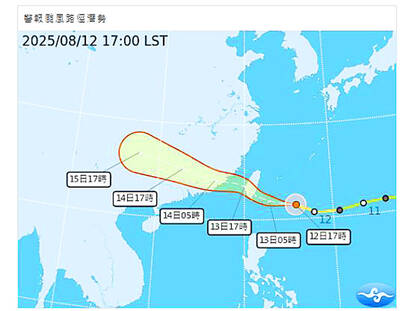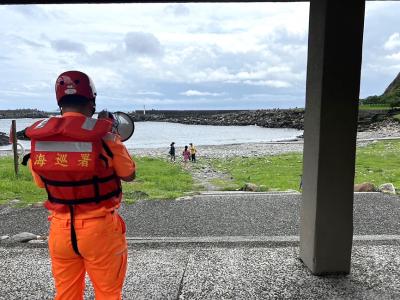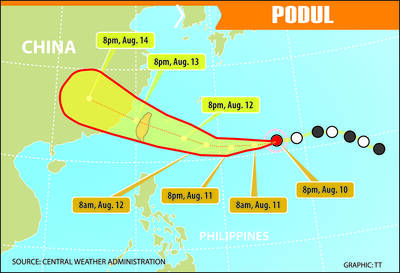China’s first landing of a plane on one of its new island runways in the South China Sea shows Beijing’s facilities in the disputed region are being completed on schedule and military flights will inevitably follow, foreign officials and analysts said.
China’s increasing military presence in the disputed sea could effectively lead to a Beijing-controlled air defense zone, they said, ratcheting up tensions with other claimants and with the US.
Chinese Ministry of Foreign Affairs officials on Saturday said that a test flight by a civilian plane landed on an artificial island built in the Spratly Islands (Nansha Islands, 南沙群島), the first time Beijing has used a runway in the area.
Vietnam launched a formal diplomatic protest while Philippines Ministry of Foreign Affairs spokesman Charles Jose said Manila was planning to do the same.
Both nations have claims to the area that overlap with China and Taiwan.
“That’s the fear, that China will be able take control of the South China Sea and it will affect the freedom of navigation and freedom of overflight,” Jose said.
In Washington, US Department of State spokesman John Kirby on Monday said China’s landing of the plane “raises tensions and threatens regional stability.”
US Senator John McCain, the chairman of the Senate Armed Services Committee, criticized US President Barack Obama’s administration for delaying further “freedom of navigation” patrols within 12 nautical miles (22.2km) of the islands built by China.
McCain said that the lack of US action was allowing China to continue to “pursue its territorial ambitions” in the region.
He said the Obama administration was “either unable to manage the complexities of interagency national security decisionmaking or simply too risk averse to do what is necessary to safeguard the rules-based order in the Asia-Pacific.”
China has been building runways on the artificial islands for more than a year, and the plane’s landing was not a surprise.
The runway on Fiery Cross Reef (Yongshu Reef, 永暑礁) is 3km long and is one of three China was constructing on artificial islands built up from seven reefs and atolls in the Spratlys.
The runways would be long enough to handle long-range bombers and transport craft as well as China’s best jet fighters, giving them a presence deep into the maritime heart of Southeast Asia.
Chinese officials have repeatedly said that the new islands would be mostly for civilian use.
However, military landings on the islands were now “inevitable,” said Leszek Buszynski, a visiting fellow at the Australian National University’s Strategic and Defence Studies Centre in Canberra.
An air defense zone, while unlikely soon, was feasible and possible in future once China builds up its air strength, he said.
“The next step will be, once they’ve tested it with several flights, they will bring down some of their fighter air power — SU-27s and SU-33’s — and they will station them there permanently. That’s what they’re likely to do,” he said.
Ian Storey, a South China Sea expert at Singapore’s ISEAS Yusof Ishak Institute, said he expected tensions to worsen as China used its new facilities to project power deeper into the South China Sea.

DEFENSE: The first set of three NASAMS that were previously purchased is expected to be delivered by the end of this year and deployed near the capital, sources said Taiwan plans to procure 28 more sets of M-142 High Mobility Artillery Rocket Systems (HIMARS), as well as nine additional sets of National Advanced Surface-to-Air Missile Systems (NASAMS), military sources said yesterday. Taiwan had previously purchased 29 HIMARS launchers from the US and received the first 11 last year. Once the planned purchases are completed and delivered, Taiwan would have 57 sets of HIMARS. The army has also increased the number of MGM-140 Army Tactical Missile Systems (ATACMS) purchased from 64 to 84, the sources added. Each HIMARS launch pod can carry six Guided Multiple Launch Rocket Systems, capable of

GET TO SAFETY: Authorities were scrambling to evacuate nearly 700 people in Hualien County to prepare for overflow from a natural dam formed by a previous typhoon Typhoon Podul yesterday intensified and accelerated as it neared Taiwan, with the impact expected to be felt overnight, the Central Weather Administration (CWA) said, while the Directorate-General of Personnel Administration announced that schools and government offices in most areas of southern and eastern Taiwan would be closed today. The affected regions are Tainan, Kaohsiung and Chiayi City, and Yunlin, Chiayi, Pingtung, Hualien and Taitung counties, as well as the outlying Penghu County. As of 10pm last night, the storm was about 370km east-southeast of Taitung County, moving west-northwest at 27kph, CWA data showed. With a radius of 120km, Podul is carrying maximum sustained

Tropical Storm Podul strengthened into a typhoon at 8pm yesterday, the Central Weather Administration (CWA) said, with a sea warning to be issued late last night or early this morning. As of 8pm, the typhoon was 1,020km east of Oluanpi (鵝鑾鼻), Taiwan’s southernmost tip, moving west at 23kph. The storm carried maximum sustained winds of 119kph and gusts reaching 155kph, the CWA said. Based on the tropical storm’s trajectory, a land warning could be issued any time from midday today, it added. CWA forecaster Chang Chun-yao (張竣堯) said Podul is a fast-moving storm that is forecast to bring its heaviest rainfall and strongest

TRAJECTORY: The severe tropical storm is predicted to be closest to Taiwan on Wednesday and Thursday, and would influence the nation to varying degrees, a forecaster said The Central Weather Administration (CWA) yesterday said it would likely issue a sea warning for Tropical Storm Podul tomorrow morning and a land warning that evening at the earliest. CWA forecaster Lin Ting-yi (林定宜) said the severe tropical storm is predicted to be closest to Taiwan on Wednesday and Thursday. As of 2pm yesterday, the storm was moving west at 21kph and packing sustained winds of 108kph and gusts of up to 136.8kph, the CWA said. Lin said that the tropical storm was about 1,710km east of Oluanpi (鵝鑾鼻), Taiwan’s southernmost tip, with two possible trajectories over the next one